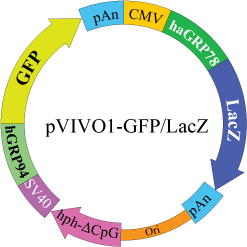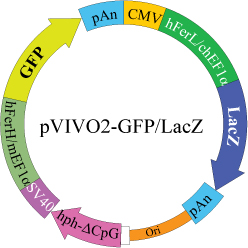pVIVO-GFP/LacZ
| Product | Unit size | Cat. code | Docs. | Qty. | Price | |
|---|---|---|---|---|---|---|
|
pVIVO1-GFP/LacZ Multigenic plasmid for high levels of expression of GFP and LacZ reporter genes in tumors |
Show product |
20 µg |
pvivo1-gfplacz
|
|
||
|
pVIVO2-GFP/LacZ Multigenic plasmid for high levels of expression of GFP and LacZ reporter genes in vivo |
Show product |
20 µg |
pvivo2-gfplacz
|
|
An innovative multigenic plasmid for high levels of expression of the GFP and LacZ reporter genes in vivo
pVIVO-GFP/LacZ plasmids are specifically designed for in vivo experiments. they allow for strong and sustained co-expression of two reporter genes: GFP and LacZ.
They contain two separate transcription units (TU), each consisting of a strong promoter and an efficient polyadenylation signal.
pVIVO-GFP/LacZ plasmids carry the hygromycin resistance gene for selection and amplification in E. coli. pVIVO-GFP/LacZ plasmids do not contain a selectable marker for mammalian cells.
Back to the topSpecifications
| Plasmid | Promoters | Expression |
|---|---|---|
| pVIVO1-GFP/LacZ | SV40/hGRP94 & CMV/haGRP78 | Stress inducible |
| pVIVO2-GFP/LacZ | SV40/hFerH/mEF1α & CMV/hFerL/chEF1α |
Constitutive |
Reporter Genes:
• LGFP: a new allele of the green fluorescent protein (GFP). The gene has been chemically synthesized to remove the CpGs.
• LacZ-ΔCpG gene: modified β-galactosidase gene. The 298 CpG motifs from the wildtype gene have been removed by chemically synthesizing the coding sequence.
Selection marker: hygromycin resistance gene for selection and amplification in E. coli. pVIVO plasmids do not contain a selectable marker for mammalian cells.
Contents
- 20 µg of lyophilized DNA
- 1 ml of Hygromycin B Gold (hygromycin) at 100 mg/ml
![]() Product is shipped at room temperature
Product is shipped at room temperature
Description
Concomitant Expression of Two Genes of Interest
pVIVO-GFP/LacZ plasmids contain two separate transcription units (TU), each consisting of a strong promoter and an efficient polyadenylation signal. Both promoters in each pVIVO-GFP/LacZ plasmid were chosen for their ability to work simultaneously, eliminating the potential risk of transcriptional interferences between the two TUs.
• pVIVO1-GFP/LacZ plasmids contain two glucose regulated protein (GRP) promoters coupled with either the SV40 or CMV enhancer. The human GRP94 and hamster GRP78 promoters drive weak levels of expression in normal conditions and are induced in stress conditions prevailing inside tumors, such as glucose deprivation and hypoxia.
• pVIVO2-GFP/LacZ plasmids contain two human ferritin composite promoters, FerH (heavy chain) and FerL (light chain), combined to the SV40 and CMV enhancers respectively. To eliminate the iron regulation, their 5’UTRs have been replaced by the 5’UTR of the mouse and chimpanzee EF-1α genes. The resulting SV40/hFerH/mEF1α and CMV/hFerL/chEF1α promoters confer high constitutive levels of transgene expression.
pVIVO-GFP/LacZ plasmids carry the hygromycin resistance gene for selection and amplification in E. coli. pVIVO-GFP/LacZ plasmids do not contain a selectable marker for mammalian cells.
Sustained Expression of the Transgenes
Both promoters in pVIVO-GFP/LacZ plasmids are of mammalian origin and can yield longer lasting expression of the transgenes in vivo compared to viral promoters. Indeed, viral DNA sequences are recognized by the host immune system leading to their inactivation usually through methylation.
To further increase the duration of expression, immunostimulatory sequences known as CpG motifs, which are present in high numbers in bacterial DNA, were removed from the plasmid backbone. These specific motifs, found in E. coli hygromycin resistance (hph), β-galactosidase (lacZ) and green fluorescent protein (GFP) genes, were eliminated by chemically synthesizing a new allele of these genes without altering the protein sequence.
Available with Two Reporter Genes
pVIVO-GFP/LacZ express two reporter genes: GFP and LacZ. GFP (green fluorescent protein) and LacZ (β-galactosidase) are commonly used reporter proteins.
The E. coli lacZ gene codes for the enzyme β-galactosidase which catalyzes the hydrolysis of the substrate X-Gal to produce a blue color that is easily visualized under a microscope.
The red-shifted variant of the jellyfish GFP gene encodes a green fluorescent protein that absorbs blue light (major peak at 480 nm) and emits green light (major peak at 505 nm).
pVIVO-GFP/LacZ plasmids can be used as control plasmids for pVIVO-MCS or cloning vectors. The reporter genes are flanked by unique restriction sites and can be easily replaced by open reading frames chosen from InvivoGen’s Gene A-List.
Back to the topDetails


• haGRP78 and hGRP94 prom: The hamster GRP78 and human
GRP94 promoters drive weak levels of expression in normal conditions and are induced in stress conditions prevailing inside tumors, such as glucose deprivation and hypoxia. Within the tumor micro-environment, the GRP promoters yield persistent expression whereas the activity of viral promoters declines rapidly.
• hFerH and hFerL composite promoters: Ferritin is a 24 subunit protein composed of two subunit types, termed H (heavy) and L (light). Ferritin is ubiquitously expressed. To eliminate the iron regulation of the ferritin promoters, the 5’UTR of FerH and FerL have been replaced by the 5’UTR of the mouse and chimpanzee elongation factor 1 (EF1) genes, respectively.
• SV40 enhancer which is comprised of a 72-base-pair repeat allows the enhancement of gene expression in a large host range. The enhancement varies from 2-fold in non-permissive cells to 20-fold in permissive cells. Furthermore, the SV40 enhancer is able to direct nuclear localization of plasmids.
• CMV enhancer: The major immediate early enhancer of the human cytomegalovirus (HCMV), is composed of unique and repeated sequence motifs. The HCMV enhancer can substitute for the 72-bp repeats of SV40 and is severalfold more active than the SV40 enhancer.
• SV40 pAn: the Simian Virus 40 late polyadenylation signal enables efficient cleavage and polyadenylation reactions resulting in high levels of steady-state mRNA.
• pMB1 ori: a minimal E. coli origin of replication to limit vector size, but with the same activity as the longer Ori.
• EM7 is a bacterial promoter that enables the constitutive expression of the antibiotic resistance gene in E. coli.
• Hygro-ΔCpG is a new allele of the hph gene conferring resistance to hygromycin B. In order to reduce the immunogenicity of this bacterial gene all CpG motifs have been removed by chemically synthesizing the gene. The Hygro-ΔCpG gene allows the selection of E. coli clones transformed with a pVIVO plasmid.
Note: Stable transfection of mammalian clones cannot be performed due to the absence of a eukaryotic promoter upstream of the Hygro-ΔCpG gene.
• Term: The E. coli rps O terminator allows efficient transcription termination of the Hygro-ΔCpG gene.
• EF1 pAn is a strong polyadenylation signal.
• LacZ-ΔCpG gene: The E. coli lacZ gene codes for the enzyme β-galactosidase which catalyzes the hydrolysis of the substrate X-Gal to produce a blue color that is easily visualized under a microscope. In order to reduce the immunogenicity of this bacterial gene the 298 CpG motifs from the wildtype have been removed by chemically synthesizing the gene.
• LGFP is a new allele of the green fluorescent protein. The gene has been chemically synthesized to remove the CpGs to ensure long-lasting expression.
Back to the top



